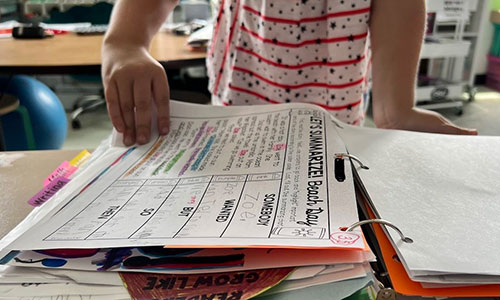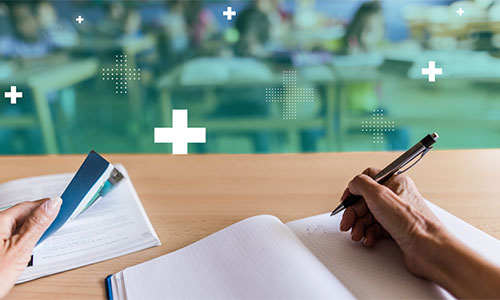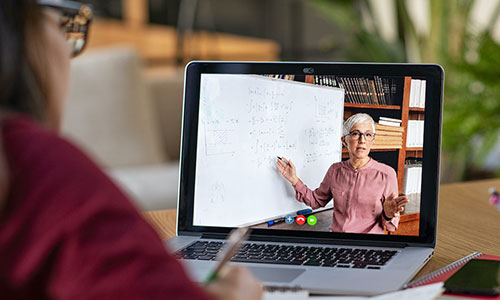Want to know a secret? I didn’t mean to become a secondary ELA teacher. One of the reasons why an ELA endorsement wasn’t originally at the top of my list was this persistent worry: how does one keep up with marking and grading all those ELA assignments? I do love a good challenge, though, so despite my concerns, I jumped into the adventure, and I am so glad that I did.
Over time, I faced that ELA assignment volume fear. Through support from mentors, observations of experts, and practice in professional development settings, I learned how to embed student self-assessment into learning processes so that my workload concerns were alleviated. More importantly, my students were able to build metacognition and self-efficacy skills.
I don’t want to give the impression that learning how to embed self-assessment processes was smooth or linear or that the process is complete for me. There was trial and error, zigs and zags, and I am still learning how to improve my practice. I hope that sharing the things I’ve learned along the way can bring relief and support you in your work.
The topic of student self-assessment is huge, so for the purposes of this blog post, I will focus on three things that I’ve learned along the way. If you want to know more about the components and benefits of self-assessment, check out this short Dylan Wiliam video. I also encourage you to read Heidi Andrade’s “A critical review of research on student self-assessment.” She asks and answers several key questions about self-assessment, including, “What is self-assessment?” and “Why self-assess?” She also digs into how it relates to feedback.
1. Reflect on your role
When I first started teaching, I was prepared to operate as a learner-manager instead of a learner-empowerer. As a learner-manager ELA teacher, I would give directions for an essay, set a due date, collect essays, take hours to mark and grade the essays, and then hand back the papers. Inevitably I would be frustrated when students ignored my marks or tossed out the paper, only to ask how to raise their grade at the end of the quarter. Ugh! Wasn’t this precisely why I hadn’t planned on being an ELA teacher?
Slowly I came to understand how important it was for me to make the shift from thinking of myself as a learner-manager (an “I say it. You do it” approach) to thinking of myself as a learner-empowerer (a “How do I partner with my students to build knowledge, skills, and self-efficacy throughout the learning journey?” approach).
Once I committed to being a learner-empowerer, my actions followed suit. I engineered learning goal paths that made students active agents in the learning processes. For example, I built in small, quick opportunities to practice self-assessing along the way so that by the time we arrived at an end point, students’ work was solid and they could reflect on the goal or explain a grade. More on that in the next tip.
2. Use reliable strategies, processes, and tools
Here are four “moves”—examples of specific actions I learned to embed in learning processes—that I think can help you as you consider the role of self-assessment in your classroom.
Nurture a community of learning
Authentic, meaningful, and effective student self-assessment requires participants to be honest and vulnerable. I had to deliberately foster a safe, respectful, and inclusive learning environment. How can you nurture a community of learning in your classroom?
Reallocate time and energy
Early in my teaching career, I was hesitant to fully dive into processes for successful student self-assessment. It felt like the learning experiences in a lesson or unit would take longer if I did because of the need to make room for the exercises that make self-assessment fruitful, such as clarifying goals, using examples, and engaging in peer feedback. I had to trust that reworking how I used teaching and learning time would pay off in the end, and it did.
By making time in the lesson or unit for the short, frequent exercises that make self-assessment successful, I spent less time tracking down unfinished work and nagging students about revisions. I also ultimately saved time grading. Once my students and I got the hang of self-assessment processes, students could reflect on the learning goals and articulate their grade rationale—and they were usually right on! No more frustration of unread markups and ignored grades.
Use examples of work
Self-assessment is even more fruitful when students can process examples of work that illustrate the learning goals and success criteria. In other words, for meaningful self-assessment, we had to work to make sure there was a solid foundation of understanding about examples and how to use the examples as a guide. After creating that solid understanding of success through examples, my students and I could take next steps with effective self, peer, and teacher feedback, which ultimately led to successful self-assessment.
I learned to start with strong examples so that students were sure to have a sound reference for what the end result should look like. Sometimes I could access these examples from the provided curriculum materials or from previous students; sometimes I made the examples myself, especially if the learning goals or path to the learning goals were specific to my students’ motivations and interests.
If my students were working on a learning goal (such as building argumentation claims and counterclaims) expressed in a multi-step product (such as a multiple-paragraph argument), we would process a whole example. We would also examine specific pieces (e.g., paragraphs or even sentences). The students and I would look for the success criteria together using processes that aligned to the learning goal(s). For instance, if we were working on argumentation learning goals, we would use an argument rubric to guide our processing of the example, usually a few parts of the rubric at a time. This practice set forth the words and procedures for effective teacher, self, and peer feedback grounded in concrete illustrations of the learning goals and success criteria. With the provided examples, we could practice a feedback strategy such as Stars (strengths) and Stairs (next steps): Using the language of the rubric, what is a strength of this argumentation example? Using the language of the rubric, what is a next step for this argumentation example? Students had plenty of practice with the strategy first for processing examples, then for practicing feedback, and finally as a frame for self-assessment: Using the language of the rubric, what is a strength of your argumentation? Using the language of the rubric, what is a next step for your argumentation?
Include self-assessment prompts during the journey and at the end
For far too long, I would tell students to self-assess and hope that they followed through. Eventually I made it a habit to embed self-assessment prompts, space, and time directly on formative (practice) and summative materials.
When relevant, I would simply embed a one-sentence self-assessment frame (e.g., “On a scale of 1–5, my claim sentence is currently a ___ because ___.”) Other times it was better to prompt more than a one-sentence self-assessment (e.g., “To self-assess your use of textual evidence to support your claim, please follow these steps: 1. In your draft, highlight where you used textual evidence to support your claim. 2. Based on the textual evidence that you used, circle your current level of skill on the provided rubric. 3. Use the information on the provided rubric to list one action you take to make your textual evidence even stronger.”) The students and I would use their self-assessment answers to plan next steps, which sometimes looked like adjusting the lesson plan for the next day for more practice or making mixed groups for the next formative exercise.
For the summative task(s), I got into the habit of making sure to include student self-assessment as the last part of the experience. For instance, if there was a written or spoken product, after the conclusion sentence, students would also self-assess using a provided frame. If the summative was a set of prompts or questions, the last prompt or question would be self-assessment.
3. Embrace the process
Figuring out the self-assessment strategies, processes, and tools that work best in partnership with your students is an ongoing expedition that requires time, patience, and a sense of humor. You’ll take steps forward, steps sideways, and steps back. It can get messy, but that’s normal. Authentic, human-centered learning is messy!
I encourage you to try one new thing at a time, celebrate quick wins, think of “failures” as learning opportunities, and lean on your students for their help. Be reassured that applying self-assessment practices is one of the most valuable parts of the learning process. For more on the value of student self-assessment, see the discussion section in “Examining the impact of self-assessment with the use of rubrics on primary school students’ performance.”
Suggested next steps
I encourage you to continue the journey of including students as active agents in the learning process. Growing in or expanding upon the practices listed here can help you continue that journey. In case you find them helpful, here are a few discussion questions that can guide your thinking about student self-assessment. Tackle them on your own or with a colleague.
Questions for teachers
- What’s one student self-assessment strategy that you already use?
- What’s one student self-assessment strategy that you would like to try?
- What support do you need to try a new self-assessment strategy?
- What will inspire you to keep up the hard work of embedding student self-assessment in the learning journey?








